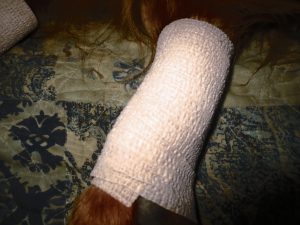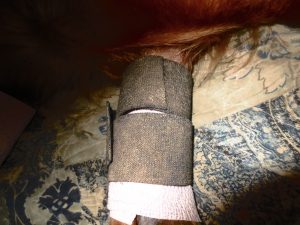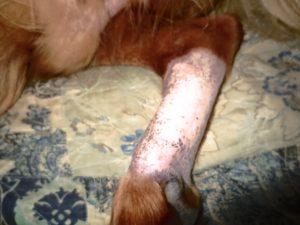Post #13 07/26/2019 Protecting Radiated Wound Areas During Healing/Chemo Period
Below are some photos of how I protect his leg while it has no fur to protect it while we are out on our walks; this protection is done in three layers:
- First I lay a pad of Telfa on the wound area (available at any pharmacy, it is a non stick, soft pad that is needed while the skin in the wound area is reforming after radiation; once the skin is intact and healthy, could stop doing this step although I like the gentle protective layer it provides).
- I then wrap a couple of layers of Gentle Wrap to further protect the wound area, and to hold the Telfa in place. This wrap sticks to itself so is easy to work with (available at CVS).
- Finally, I cover the wrap with a couple of two inch wide double sided (sticks to itself ) Velcro strips that act as an “armor plate” to prevent brush and brambles from harming the wound and to keep the wrap in place.
The photos below show the bare leg, then with the gentle wrap over the Telfa pad and finally, with the Velcro strips as protection for the wrap. At the end of this post, I show photos of the products being used here.
The materials I am using both to protect the leg wound and the Aloe product I spray on several times a day to promote healing are shown at the end of this post.
When the wound condition allows, this approach is infinitely better than the array of dog boots out there, which are clumsy, rarely stay on for long, and are not fully water proof anyway. Of course, a boot was needed when the wound on his leg was still open after surgery, and his activity had to be highly restricted anyway. This period was a real headache for us both. So, boots do serve a purpose.
I should say when we walk, he is always off leash because we go to places where there are rarely people or cars, places with woods, fields, rabbits, deer, and other wildlife one would expect in this part of the world. We also go out in all kinds of weather, rain or shine, cold or hot; could be a blizzard or pouring rain but he still needs to poop. So, we go.
When we are out walking, I let him lay in puddles to cool off, walk through streams, and do whatever makes him happy. I am going to remove the wrap as soon as we get home, dry him off and spray his wound areas with Aloe Vera anyway.
These walks are his time.
His time to nose around, pee 50 times, explore the world, poop of course, and simply enjoy being alive. I want him to have a life worth living so I give him as much time as I have or he seems to need. When he is done, he tells me by lying down next to the car – in the shade during the summer, in the sun during winter.
Before cancer, I walked with him and we both got exercise; now, I have to restrict his activity until his hair grows back. I have found the best way to do this is for me to hang around the car or sit in it, maybe listening to music or read a book. Then he simply meanders around on his own at a gentle pace.
Because this is the nature of GR’s, he does not go far from where I am, ranging out not more than, say, 50 yards or so. I can almost always keep him in sight and if he is out of sight too long, I whistle him back.
I have an e-collar on him with three options: send him a brief shock, a longer one if the situation calls for it, or, as is true 99% of the time, simply a high pitched noise only he can hear but is startling to him. Finally, he comes to a just a whistle extremely well too.
I might have to shock him 1-2 times/yr these days (if he decides to chase people, another dog, or a car). If he sees and wants to chase a deer (like any bird dog, he gives up within 50 yards and comes back) or some turkeys, l let him have his fun.
We understand each other.








Recent Comments